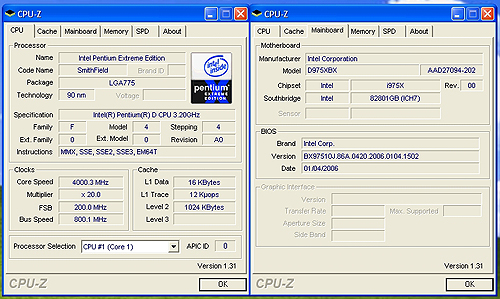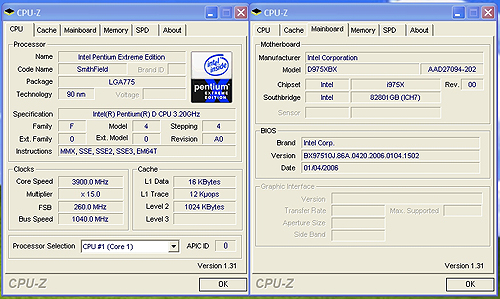Intel D975XBX: Intel brings their Bad-Axe to Market
by Gary Key on January 26, 2006 12:05 AM EST- Posted in
- Motherboards
FSB Overclocking Results
We tried two other boards, but we did not have success in increasing the CPU multiplier past 20 or utilizing a combination of the CPU multiplier and the FSB frequency override setting past the reported numbers. Even though this particular CPU has reached 4.4GHz, we could not pass the 4.0GHz mark and maintain stability or complete our test suite. We will be receiving a retail board shortly and will re-examine the overclocking ability of the board with our 840EE, 950D, and 955EE processors.
Memory Stress Testing
Memory stress tests look at the ability of the Intel D975XBX to operate at the officially supported memory frequencies of 667MHz DDR2, at the best performing memory timings that the Corsair CM2X512A-5400UL revision 1.3 will support.
The Intel D975XBX was very stable with 2 DDR2 modules in Dual-Channel at the settings of 3-2-2-8 at 2.1V. We will now install all four available memory slots that are usually more strenuous on the memory subsystem than testing 2 DDR2 modules on a motherboard.
The Intel D975XBX was completely stable with 4 DDR2 modules in Dual-Channel at the settings of 4-2-3-8 and needed the voltage increased to 2.2V. We tried several combinations of memory settings at the CAS Latency of 3, but the board was not stable enough to complete our test suite. This is the first i975x board that we have tested that did not allow a CAS Latency of 3 in our testing with 4 DDR2 modules.
| Front Side Bus Overclocking Testbed | |
| Processor: | Pentium 4 Smithfield LGA 775 840EE Dual Core 3.2GHz |
| CPU Voltage: | 1.5125V (1.4000V default) |
| Memory Settings: | 3-2-2-8 at 667MHz |
| Memory Voltage: | 2.2V |
| MCH Voltage: | 1.60V |
| ICH Voltage: | Default |
| Cooling: | Thermaltake Big Typhoon |
| Power Supply: | OCZ Power Stream 520 |
| Maximum CPU OverClock: | 200fsb x 20 (4000MHz) +25% |
| Maximum FSB OverClock: | 260fsb x 15 (3900MHz) +30% |


We tried two other boards, but we did not have success in increasing the CPU multiplier past 20 or utilizing a combination of the CPU multiplier and the FSB frequency override setting past the reported numbers. Even though this particular CPU has reached 4.4GHz, we could not pass the 4.0GHz mark and maintain stability or complete our test suite. We will be receiving a retail board shortly and will re-examine the overclocking ability of the board with our 840EE, 950D, and 955EE processors.
Memory Stress Testing
Memory stress tests look at the ability of the Intel D975XBX to operate at the officially supported memory frequencies of 667MHz DDR2, at the best performing memory timings that the Corsair CM2X512A-5400UL revision 1.3 will support.
| Intel D975XBX Stable DDR667 Timings - 2 DIMMs (2/4 slots populated - 1 Dual-Channel Bank) |
|
| Clock Speed: | 200MHz (800FSB) |
| Timing Mode: | 667MHz - Default |
| CAS Latency: | 3 |
| RAS to CAS Delay: | 2 |
| RAS Precharge: | 2 |
| RAS Cycle Time: | 8 |
| Voltage: | 2.1V |
The Intel D975XBX was very stable with 2 DDR2 modules in Dual-Channel at the settings of 3-2-2-8 at 2.1V. We will now install all four available memory slots that are usually more strenuous on the memory subsystem than testing 2 DDR2 modules on a motherboard.
| Intel D975XBX Stable DDR667 Timings - 4 DIMMs (4/4 slots populated - 2 Dual-Channel Banks) |
|
| Clock Speed: | 200MHz (800FSB) |
| Timing Mode: | 667MHz - Default |
| CAS Latency: | 4 |
| RAS to CAS Delay: | 2 |
| RAS Precharge: | 3 |
| RAS Cycle Time: | 8 |
| Voltage: | 2.2V |
The Intel D975XBX was completely stable with 4 DDR2 modules in Dual-Channel at the settings of 4-2-3-8 and needed the voltage increased to 2.2V. We tried several combinations of memory settings at the CAS Latency of 3, but the board was not stable enough to complete our test suite. This is the first i975x board that we have tested that did not allow a CAS Latency of 3 in our testing with 4 DDR2 modules.










34 Comments
View All Comments
BigP - Wednesday, June 21, 2006 - link
Im a self build Virgin - but I'm going in at the deep end. Intel's site makes their Dual Core stuff sound awsome!(a) Is it?(b)Should I look to spend my cash elsewhere when considering a motherboard/processor?Gary Key - Saturday, July 15, 2006 - link
This board is fine for stock performance and if you get rev-0304 it works very well with Core 2 Duo.FOXY25 - Sunday, February 4, 2007 - link
hi that are my system setting. My system sometimes make complete restart and i dont know why. I have change entire board with another and nothing. Do y think that could be in memory i have 2x DDR2 1024 MB at 800 Mhz Kingmax. thanks for answer.Foxy====== Board ======
Manufacturer Intel Corporation
Product Name D975XBX
Version AAD27094-306
Serial Number BQBX645001ND
BIOS Version BX97510J.86A.1476.2007.0119.1334
BIOS ROM Size 512 KB
BIOS Release Date 19.1.2007
====== Processor ======
Manufacturer Intel(R) Corporation
Processor Name Intel(R) Core(TM)2 CPU 6400 @ 2,13GHz (2 Cores)
Bus Speed 1067 MHz
Processor Speed 2,133 GHz
Stepping 6
Form Factor Other
Hyper-Threading Technology Status Not Supported
====== Cache ======
L1 Cache Data Cache 32 KB, Code Cache 32 KB Per Processor Core
L2 Cache 2048 KB Unified Cache (2048 KB Cache Per 2 Cores)
====== Memory ======
Error Correction Single-bit ECC
Maximum System Memory 4 GB
Memory Slots 4
---- CHAN A DIMM 0 ----
Socket Designation CHAN A DIMM 0
Current Memory Type DDR2
Installed Size No Module Installed
---- CHAN A DIMM 1 ----
Socket Designation CHAN A DIMM 1
Current Memory Type DDR2
Installed Size 1024 MB
Memory Speed 800 MHz
---- CHAN B DIMM 0 ----
Socket Designation CHAN B DIMM 0
Current Memory Type DDR2
Installed Size No Module Installed
---- CHAN B DIMM 1 ----
Socket Designation CHAN B DIMM 1
Current Memory Type DDR2
Installed Size 1024 MB
Memory Speed 800 MHz
====== Onboard Devices ======
#Device Type Ethernet
Device Description Intel (R) 82562 Ethernet Device
Device Status Enabled
#Device Type Sound
Device Description Intel(R) Azalia Audio Device
Device Status Disabled
#Device Type Other
Device Description Silicon Image 3114 SATA RAID Controller
Device Status Disabled
#Device Type Other
Device Description Texas Instruments TSB82AA2 1394A/B Controller
Device Status Disabled
====== Hard Drive ======
#Model ST3320620AS
Max. Transfer Mode UDMA 6 (ATA/133)
Active Transfer Mode UDMA 5 (ATA/100)
S.M.A.R.T. Status Enabled
Size 298,09 GB
#Model ST380811AS
Max. Transfer Mode UDMA 6 (ATA/133)
Active Transfer Mode UDMA 5 (ATA/100)
S.M.A.R.T. Status Enabled
Size 74,53 GB
JarrettV - Thursday, February 23, 2006 - link
Does this board support dolby digital live in the sigmatel audio chipset? I'm looking to replace my old SoundStorm setup.Also, does Intel High Definition = Dolby Digital Live support?
neilfeier - Wednesday, February 22, 2006 - link
Unlike most users of this motherboard that want to use the dual x8 PCIe slots for graphics, I want to use them for benchmarking a pair of x4 data acquisition boards we are developing. I want to test max rates to and from memory, as well as peer-to-peer transfers between the two boards (assuming the MCH allows this).So my question is: Do you think I can I put a x16 or x8 PCIe graphics card in the third x4 PCIe slot hanging off the south bridge? I don't care about graphics performance too much, I just want a dual monitor card that will work in that slot and leave the main two slots free.
And ideas on this would be helpful. Thanks!
Gary Key - Wednesday, February 22, 2006 - link
I will try it this weekend and report back.neilfeier - Friday, March 3, 2006 - link
Thanks Gary, I anxiously await the results of your experiment.Neil
Gary Key - Thursday, March 9, 2006 - link
Hi Neil,I had video working in this slot. I updated to the new bios release today and will test the performance in a couple of days.
Thanks,
Gary
Gary Key - Tuesday, March 28, 2006 - link
Neil,Performance is average but it works.
Gary
Missing Ghost - Monday, January 30, 2006 - link
error! That's not how pcie works! pcie is always full duplex, and never single-ended!